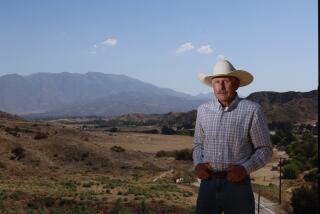City Center for the Eastside?
First floor, linens. Ninth floor, home sweet home?
Sears, Roebuck & Co.’s long-shuttered Boyle Heights distribution center, one of the largest buildings completed in Los Angeles during the 1920s, may wind up as the centerpiece of a proposed 23-acre retail and residential project.
Developer MJW Investments hopes to start work next year on a renovation of the nine-story, 1.8-million-square-foot building at Olympic Boulevard and Soto Street and the vast parking lot surrounding it.
The project, which could cost as much as $350 million, is an ambitious attempt to build a pedestrian-oriented shopping and residential district.
The goal, developers say, is for it to resemble a city center and not a mall.
“It will be more like Westwood than it is like the Grove,” said Pasadena architect Stefanos Polyziodes, the developer’s lead design consultant. While the Grove, a popular outdoor shopping center in the Fairfax district, is mostly walled off from the street, “Westwood is the quintessential open town center.”
Preliminary plans include 480 condominiums, 180 apartments and 750,000 square feet of stores and restaurants laid out on streets that would pass through the property. The hulking Sears building would house stores including Sears on the first floor. The next two floors would include commercial space and possibly a charter school and parking.
The remaining floors would have apartments facing the downtown skyline and more parking. On the roof would be a garden, tennis courts, a swimming pool and other amenities for tenants.
The building was one of nine mail-order fulfillment centers that Sears built between 1910 and the onset of the Great Depression. Its nearest counterpart, in Seattle, has been converted to a retail, office, warehouse and manufacturing center. The Sears warehouse in Boston also has been transformed into a commercial center.
The Boyle Heights building, completed in phases starting in 1927, attracted more than 100,000 curious visitors in its first month of operation, The Times reported that year. That didn’t include shoppers at the company department store on the first floor.
Sears employees filled mail orders by roller skating around the 200,000-square-foot floors -- about the size of a big-box store such as Costco today -- picking up items and dropping them onto corkscrew slides for distribution by truck or rail, said Tim Meier of MJW Investments.
The store on the first floor is still in operation, but the catalog center closed in 1992 and the property was sold as part of a cost-cutting program. That left a hole in Boyle Heights, where the Sears complex employed 1,000 workers at the time it closed.
The Sears sign atop a 14-story tower above the building was a beacon for Eastsiders returning home on area freeways, said Ken Bernstein of the Los Angeles Conservancy.
“The Sears building with its Art Deco tower is clearly one of the dominant visual icons of the Eastside,” he said.
MJW President Mark Weinstein said his great-grandparents and grandparents lived in Boyle Heights and took him to Sears as a child. He hopes to enhance the neighborhood with a center where residents can shop, eat and perhaps watch a movie.
The more than 1 million residents within a five-mile radius of the site have few retail options beyond small neighborhood shops, according to a study by the city’s Community Redevelopment Agency. Residents leave the area to spend millions of dollars annually.
Retail tenants other than Sears haven’t been inked because the project has yet to receive city approval. MJW officials have been meeting with neighborhood representatives to garner support for their plans.
MJW has acquired most of the site from Arizona-based Univest and has the final parcel in escrow, Weinstein said.
With the Sears site acquisition, MJW owns more than 5 million square feet of real estate, including apartments, shopping centers, industrial properties and self-storage buildings. Its largest project is Santee Court, a collection of nine office buildings on Los Angeles Street that are being converted to apartments and condominiums.
More to Read
Inside the business of entertainment
The Wide Shot brings you news, analysis and insights on everything from streaming wars to production — and what it all means for the future.
You may occasionally receive promotional content from the Los Angeles Times.











